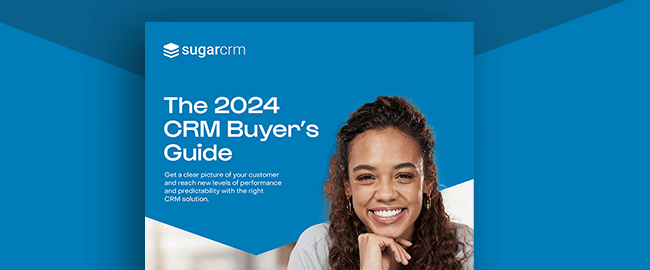SugarCRM vs. Salesforce: 5 Reasons Why You Should Choose Sugar Sell
If you’re asking “Is SugarCRM the same as Salesforce?”, the answer is no. But these two customer relationship management (CRM) systems have a lot in common.
Determining which one is best for your business will depend on what you’re looking for. If you’re searching for a great value CRM, SugarCRM’s Sugar Sell may be the Salesforce alternative that’s right for you.
To help you decide, we’ve compared Salesforce versus SugarCRM.
What we'll Cover:
SugarCRM vs Salesforce: Features Summary
When comparing Salesforce vs SugarCRM, a key difference is that SugarCRM is usually set up to suit teams with at least ten users. In contrast, Salesforce markets itself to businesses of all sizes.
However, this doesn’t mean that you can’t use Sugar as a small business. The entry-level subscription for SugarCRM’s Sugar Sell is cheaper than Salesforce’s Sales Cloud’s smallest option. Sugar Sell’s most advanced subscription is also more affordable than Sales Cloud’s nearest equivalent. So, whether you’re looking for a CRM for an e-commerce start-up or an established large business, SugarCRM may be your most cost-effective option.
Of course, pricing won’t be the only factor that determines the CRM you use. However, the cost is important to consider when assessing how much value you will get from your CRM. Before we go into each area in more detail, we’ve put together this table to help you compare SugarCRM and Salesforce features at a glance:
SugarCRM’s Solutions
SugarCRM is made up of four core solutions:
- Sugar Market
- Sugar Sell
- Sugar Serve
- Sugar Enterprise
Sugar Sell slots conveniently into the SugarCRM ecosystem. Sugar solutions work together to generate a complete customer relations management experience:
- Sugar Market is a marketing automation tool that helps you research your consumer base, gain visibility in the marketplace, and generate new leads.
- Sugar Sell brings all customer data into one place, with built-in reporting, sales forecasting, product catalog and quote management, and business process management (BPM) features.
- Sugar Serve makes customer service simple with at-a-glance customer service histories and convenient self-serve portals.
- Sugar Enterprise provides the power and ease of use that Sugar is known for in an on-premises package supporting higher levels of customizability and control
Every part of the SugarCRM ecosystem works seamlessly as a standalone unit or as part of the whole. Helpful SugarCRM features help users to
Once you get the hang of Sugar Sell—and Sugar University can help you learn the ropes in a hurry—you’ll find other Sugar solutions much easier to use.
SugarCRM vs Salesforce: Pricing
As of June 2024, SugarCRM’s Sugar Sell is cheaper than Salesforce’s Sales Cloud across almost all tiers.
Starting at just $19 USD per month per user, Sugar Sell gives small teams of 3-5 access to the features they need and allows them to easily upgrade once they scale.
When comparing SugarCRM with Salesforce, it’s important to look at the prices of all solutions across the ecosystems. For instance, Salesforce’s Marketing Cloud starts at $1,250 USD per organization per month (billed annually). For comparison, Sugar Market starts at $1,000 per month for 10k contacts with unlimited users (billed annually).
While you can use separate elements of SugarCRM and Salesforce, many business owners value keeping everything in the same ecosystem. Therefore, it’s wise to compare prices of the different solutions you may use (now or in the future) in addition to Sugar Sell.
To accurately assess costs, you also need to be aware of hidden costs. With Salesforce, for example, you could be liable for upcharges for system usage (such as API calls). Choosing a non-compatible CRM vendor comes with risks, so take your time when choosing so that you know what you’re getting and what you’ll be paying for.
SugarCRM vs Salesforce: Ease of Use
When you use Sugar Sell you can put vital business processes on autopilot using convenient drag-and-drop visual design interfaces. Complementary solutions like SugarBPM remove barriers to success by turning complicated workflows into interactive diagrams. Easy-to-understand icons represent specific actions, which optimize complex decision cycles using powerful predetermined rules and next-best actions.
Sugar Sell benefits from excellent user experience (UX). With its user-friendly interface, as soon as you log onto your dashboard, you will see a breakdown of service, sales, and marketing campaign data, all arranged on a clean, white background. Updates and messages pop up immediately so you can get to work on the most pressing issues right away.
Sales representatives using the Sugar Sell system gain instant access to customer histories, hierarchies, and coverage. Sugar Sell is straightforward for sales representatives to use this data to provide each consumer with a personalized experience, resulting in what every organization strives for,increased customer satisfaction.
Thanks to a user-friendly interface, managers can troubleshoot problems more quickly, using process monitoring and audit tools. Visual snapshots of ongoing sales workflows come in handy at meetings because they make your sales process much easier to explain. Customer histories are also easy to locate and navigate, so representatives know exactly what to say at any given moment. In a nutshell, Sugar has workflow convenience down pat.
SoftwareReviews found that SugarCRM offered a better product experience on mobile and greater ease of administration than both Salesforce and HubSpot.
SugarCRM vs Salesforce: Customer Support
Sugar Sell does not disappoint in the customer service and support department, either.
All Sugar customers get a free customer-facing self-service portal stocked with self-help documents. Because of its open-source origins, SugarCRM also has a dedicated community whose members offer enthusiastic help to CRM beginners. SugarClub is home to user forums, live and on-demand training classes, and a ton of educational resources. Plus, SugarCRM’s support page makes it easy for any user to submit a case if needed, or search through helpful articles.
Sugar also offers other valuable customer support tools like responsive phone support, live chat, and troubleshooting via email. The level of support available will depend on each customer’s chosen Sugar product.
Sugar offers flexible support options:
- Basic – 8×5 regional email support
- Standard – 12×5 (i.e. business hours, Monday-Friday) regional email and phone support
- Enhanced – 12×5 regional support, live chat availability, and a priority phone queue
- Premium – 24×7 global support (for P1 cases), access to multi-region support, priority case routing, and a dedicated senior support team
Basic Support is included with Sugar Sell Essentials. Standard Support comes free with Sugar Sell Advanced, while Enhanced Support is part of Sugar Sell Premier. Those who wish to receive more support than their Sugar Sell package have the option to purchase Enhanced or Premium Support separately.
As for Salesforce, it also offers tiered levels of customer service support. Regular users, or Standard Support Customers, can call during business hours. Standard Support Customers also only receive phone support for what Salesforce calls Severity 1 issues which include:
- “Critical production issue affecting all users.”
- “System unavailability and data integrity issues with no workaround available.”
This means serious issues like “major functionality” being impacted, “significant performance degradation”, or time-sensitive “requests for feature activation or a data export” require users to open a support case and wait for a reply while key features are unusable. Salesforce’s Premier Support Customers can get phone support 24/7, but they don’t enjoy the benefits of a dedicated account manager who knows their account inside and out.
Customer experience is another area where SugarCRM was rated highly by SoftwareReviews in its 2024 CRM Midmarket Emotional Footprint. SugarCRM came out top for overall service experience, as well as being the most transparent and caring.
SugarCRM vs Salesforce: Integrations
Sugar works beautifully with a range of other integration capabilities, including Slack, social media channels like Twitter/X and LinkedIn, telephony apps such as Cisco Webex and GoToMeeting. Meanwhile, SugarCRM’s financial data streams effortlessly into Sage Intacct and QuickBooks.
Many of SugarCRM’s built-in connectors (such as OneDrive, SharePoint, Microsoft Outlook, Gmail) are either unique to Sugar or uniquely free. While some CRM providers charge for these integrations, Sugar doesn’t.
In addition, Sugar’s open API and SDK means you can extend its user interface according to your business’s bespoke needs. With the power in your hands, you can customize SugarCRM in any way you want.
SugarCRM also offers its subscribers an omnichannel customer relations management experience. It has a convenient mobile app, so sales representatives can work on smartphones and tablets as well as laptop or desktop computers. And with convenient Geo Mapping capabilities and offline mode, representatives can map and attend meetings with ease. To put it simply: Sugar Sell makes it a breeze to work on the go.
We actually have a ton of built in connectors that are free of charge that our competitors don’t have or charge for. Like OneDrive, SharePoint, Outlook/Gmail, etc.
Doesn’t make sense to focus on remote work so much for sales reps. I would focus on mobility on the road for meetings, etc. We also have convenient geomapping capabilities and offline mode so they can map and attend meetings with ease.
SugarCRM vs Salesforce: The verdict
SoftwareReviews named SugarCRM as a 2024 Leader in Customer Relationship Management – Midmarket, with Sugar outranking Salesforce (and HubSpot and Microsoft Dynamics 365) across customer experience, product experience, and strategy and innovation.
A consistent PCMag Business Choice Award winner for reliability, satisfaction, and tech support, Sugar Sell’s powerful features deliver in so many ways: they’re easy to use, a central part of the wider SugarCRM ecosystem, have a logical workflow, and integrate smoothly with other tools.
Finally, Sugar’s customer service team responds quickly to queries, alleviating minor technological headaches in minutes.
Sweet by name and sweet by nature, Sugar Sell is an excellent ingredient for CRM success.
FAQs
Does SugarCRM integrate with Salesforce?
Sugar Market can natively integrate with third-party CRMs including Salesforce, Microsoft Dynamics, Infor, Sage, NetSuite and Bullhorn. Of course, Sugar Market also integrates with Sugar Sell as part of the wider SugarCRM ecosystem.
What is the difference between SugarCRM and Salesforce?
SugarCRM is available on the cloud or via on-premises deployment, while you can only access Salesforce on the cloud.
While they are both popular CRMs with wider ecosystems, only SugarCRM gives businesses the option of having an on-premises CRM or a hosted CRM.
How much is SugarCRM vs Salesforce?
As of June 2024, SugarCRM’s Sugar Sell starts from $19 USD per user per month while Salesforce’s Sales Cloud starts from $25 USD per user per month. Overall prices vary based on package type and how many other elements of the ecosystem a business requires (e.g. Sugar Serve vs Service Cloud, Sugar Market vs Marketing Cloud, etc.).
For more information on the cost of SugarCRM, visit SugarCRM’s pricing page.
Interested in learning even more about SugarCRM vs. Salesforce and how seamless a switch between the providers can be? Download our guide, “Switching from Salesforce to SugarCRM”.








